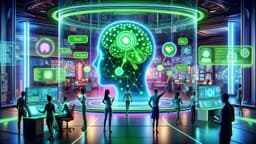What Is 'from openai import OpenAI' in OpenAI Documentation?
Imagine you have just stumbled upon an exciting piece of code, and it reads, from openai import OpenAI. Instantly, it sparks your curiosity. What does it mean? Let's dive into the world of OpenAI and break it down.
In programming, particularly in Python, using statements like from ... import ... is a common practice. It helps developers bring specific parts of a package, module, or library into their current project. It’s as if you’re selecting only the specific tools you need from a large toolkit.
What is OpenAI?
Before we understand the code snippet, let’s talk a bit about OpenAI. OpenAI is an artificial intelligence research lab consisting of the for-profit OpenAI LP and the nonprofit OpenAI Inc. It was founded by prominent figures such as Elon Musk and Sam Altman. OpenAI aims to ensure that artificial general intelligence (AGI) benefits all of humanity. They create and promote friendly AI to help make the world a better place.
You can learn more about them and their mission on their official website.
Breaking Down the Code
from openai ...
This part tells Python where to look. OpenAI provides a suite of tools and libraries that make it easy to work with advanced artificial intelligence. When you write from openai, you’re saying, "Hey Python, I need something from that OpenAI toolkit!"
... import OpenAI
Here’s the exciting part – what exactly are we importing? In this simple phrase, import OpenAI, you’re bringing in a specific part of the toolkit known as OpenAI.
The Power of Libraries
Think about your favorite streaming service, like Netflix or Spotify. You don’t always watch every single show or listen to every song. Instead, you pick the ones you like. Similarly, in Python, complete libraries include various modules and classes. You don’t need to load everything; just select what's necessary.
Why Import Specific Functions or Classes?
You might wonder why we don’t just import the entire OpenAI library. Well, one reason is efficiency. By specifying what you need, you keep your program lightweight. It’s like packing for a trip – you bring only what you intend to use.
Another reason is readability. When others read your code, they can immediately see what components are in play. This clarity makes collaboration easier and the code easier to maintain.
Using OpenAI in Your Project
When you include from openai import OpenAI in your code, you gain access to powerful tools. OpenAI provides APIs that can help you do things like natural language processing, running text analytics, generating human-like text, and much more.
Sample Code
Here's a simple example to illustrate how you might use OpenAI in your project:
Python
This snippet initializes the OpenAI client and uses it to generate a creative story. The engine specifies which model to use, the prompt is the starting text, and max_tokens defines the length of the output.
Benefits of Using OpenAI
Incorporating these tools allows developers to add sophisticated AI capabilities to their projects without building these complex systems from scratch.
Creativity and Automation
OpenAI can help bring your creative ideas to life through text generation, language translation, and even creating poetry or stories. It isn’t just about ordinary automation; it’s about intelligent automation that mimics human creativity.
Enhanced User Experiences
Developers can create more engaging and intuitive user experiences. Whether it’s through chatbots that hold natural conversations or smart applications that understand and respond to user input, the possibilities are vast.
Research and Development
For researchers, OpenAI’s tools can accelerate experimentation and discovery. With powerful AI models at their disposal, researchers can test hypotheses more rapidly, analyze complex data, and uncover new insights.
When you see from openai import OpenAI, it speaks volumes about the tremendous potential that lies within a few lines of code. It’s about harnessing the power of state-of-the-art artificial intelligence to create, innovate, and advance various fields. From developers working on cutting-edge technologies to hobbyists experimenting with new ideas, OpenAI offers the tools to make grand visions a reality.
The next time you come across this statement, remember – it’s your gateway to a world of endless possibilities driven by artificial intelligence. Whether you’re writing a small script or working on a large-scale project, importing OpenAI equips you with a tool that can bring extraordinary capabilities to your fingertips.












